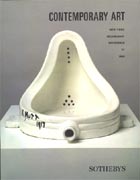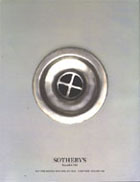Marcel
Duchamp: Money Is No Object * by Francis M. Naumann
In the nearly thirty-five years that have passed since Duchamp’s death, there has been a steady increase in the attention devoted to his work, not only by art historians, but also within the world of contemporary art. Certainly the retrospective exhibitions that were held in Philadelphia and New York (1973), Paris (1977), and Venice (1993), contributed to the appreciation of his work, as did the numerous articles and books on the artist that have appeared with consistency over the years. But exactly how much this kind of attention affects the financial evaluation of his work is difficult to determine with any degree of accuracy. Historical importance and contemporary relevance are certainly factors that should be taken into consideration when one attempts to evaluate a given work of art, but, as we shall see, taste (a factor Duchamp’s work confronts by its very nature) and quantity (which he attempted to control) are even more relevant concerns in a fickle and continuously changing art market. In the late 1960s and early 1970s, Arturo Schwarz, Duchamp’s dealer in Milan, continued to sell examples of the artist’s work, as did a number of galleries in other parts of Europe and the United States. Schwarz still had nearly all of the readymades that were produced in the 1964 edition. At the time they were issued, the complete set was priced at $25,000. So far as is known, there were only two takers: the National Gallery of Canada, and the Cordier & Ekstrom Gallery in New York. The Canadian purchase took place through the efforts of Brydon Smith, Curator of Contemporary Art at the museum. In 1970, Smith approached Schwarz with an interest in purchasing the entire set of readymades, but discovered that there was not enough money left in the museum’s purchase account for that particular year. The following year the museum experienced a surplus in their operating budget, and through a skillful reappropriation of these funds, they were able to make the acquisition. “It was rather in the spirit of Duchamp,” Smith later mused, for the readymades were purchased “from an account usually reserved for office supplies and other such useful materials.”(1) The second set of readymades ended up in an even more unlikely institution: the Art Museum of Indiana University in Bloomington, Indiana. In 1971, Thomas T. Solley, director of the museum, was approached by Arne Ekstrom, owner of the Cordier & Ekstrom Gallery, through which Solley had made various purchases over the years. Ekstrom wanted to know if he would be interested in acquiring the complete set of readymades (which Ekstrom had purchased from Schwarz in the mid-1960s for a Duchamp exhibition at his gallery, and which were then languishing in his storage facility). Through the museum, Solley contacted a donor who agreed to facilitate the purchase, and the readymades were shipped out to Bloomington, where, to this very day, they remain on public display in the University Art Museum. Even though the purchase price had risen to $35,000 (a considerable sum in those years), the expenditure was not challenged by members of the art faculty, but was, surprisingly, applauded.(2) In the end, it would prove to be a very wise investment, for, as we shall see, within thirty years the entire set of Duchamp readymades would escalate in value to well over one hundred times that amount. In contrast to the success of these private sales, the first attempt to sell the readymades at public auction proved a surprising and unexpected disappointment. In 1985, Sotheby’s in London offered “A Collection of Dada Art,” which was identified in the catalogue as “property of a Swiss collection, formerly the collection of Arturo Schwarz, Milan” (Fig. 1). Schwarz had closed his gallery ten years earlier, and the 261 separate lots in this auction represented the remaining inventory from his commercial activities (he had kept the most important pieces for his own private collection). Included was work by some of the most notable of Dada artists: Hans Richter, Hanna Hoch, Max Ernst, George Grosz, Marcel Janco, Kurt Schwitters, Francis Picabia, Man Ray, and a selection of works by Duchamp. The sale concluded with the complete set of readymades issued by the Galleria Schwarz in 1964 (Fig. 2), offered, however, as separate lots. Bidding for these items was anything but brisk. In the end, six of the smaller readymades sold, but at prices that were only about half their pre-sale estimates. This would indicate that the auction house set the reserve (the lowest price at which a work can be sold) unusually low, far lower than the low of the estimate. Despite this strategy, seven of the more important readymades — Bicycle Wheel, Bottle Rack, In Advance of the Broken Arm, Fountain, among others — failed to sell. Nevertheless, within a few weeks after the sale, Sotheby’s managed to find buyers for all the readymades that still remained in their possession, but at prices that were a fraction of the pre-sale estimates.(3)
The lack of success in selling these works did not prevent at least one newspaper — the anything-but-respected National Enquirer — from asking its readers if the readymades were “Art or Junk?” (Fig. 3). The tabloid reproduced a selection of the objects with their prices, alerting their readers to the fact that “folks are asking a fortune for this stuff.” When an expert at Sotheby’s was asked to explain the “outrageous amounts... these wacky ‘artworks’ are worth,” she wisely replied: “It requires a great deal of knowledge of twentieth-century art to understand these pieces.” Few would argue with that explanation; to understand the prices would have required a great deal of knowledge of twentieth-century art, but also a thorough knowledge of the market in twentieth-century art. The ideas Duchamp introduced continue to represent an influential force in the world of contemporary art, a factor that — one would assume — affects the financial evaluation assigned his work. This point was dramatically demonstrated in 1997 when one of the examples of Fountain from the Schwarz edition was offer by Sotheby’s in New York as part of their autumn sale of Contemporary Art (Fig. 4). Fourteen years had passed since the Schwarz sale in London when this same work failed to sell, but times had changed. The work was considered so important that the auction house decided to reproduce it on the front cover of its catalogue, and, in a clever decision (since the two works seem to share a common theme), Robert Gober’s Drain was chosen to appear on the back cover. I was asked by the auction house to write an entry on
A knowledge of prior sales may have contributed to the exceptionally high price paid for this work, but there were other factors as well. In the days immediately preceding the sale, Daskalopoulos’s advisor in art purchases called me several times from Athens to inquire exactly how this particular example of Fountain differed from one owned by Dakis Joannou, another Greek collector of modern art. Dakis’s Fountain, I explained, came from the collection of Andy Warhol, but it did not bear the important brass plaque that identified the work as part of the edition of eight signed and numbered examples.(5) So far as I could determine, the work being sold by Sotheby’s was the very last example of Fountain from the Schwarz edition that was ever likely going to be made available for sale (the location of the seven other examples of this work from the complete edition of eight accompanied my essay in the catalogue).(6) It should also be noted that as a collector of contemporary art, Daskalopoulos was certainly familiar with the high prices that were usually paid to secure important work. In fact, the two lots that directly preceded the sale of Fountain in the Sotheby’s auction sold for prices that either equaled or exceeded the amount paid for this particular readymade: a Jasper Johns drawing of a Flag sold for $1,762,500, and one of Andy Warhol’s paintings of wanted men (which was compared in the catalogue to Duchamp’s Wanted Poster of 1923/63) sold for $1,982,500. Even these prices were not exceptional when compared with the record-breaking $11 million dollars that was paid for a painting by Mark Rothko that followed a few lots later in the same sale. When it came to assessing the success of this sale, however, few neglected to mention the record-breaking price for a work by Duchamp.>>Next
page 1 2 * This essay was originally intended to serve as the second half of an article dealing with the general topic of Duchamp and money. The first part—which deals with the subject of how Duchamp used money in both his art and life—appeared in the April 2003 issue of Art in America. Notes
Fig.
2 |
|||||||||||||||

















